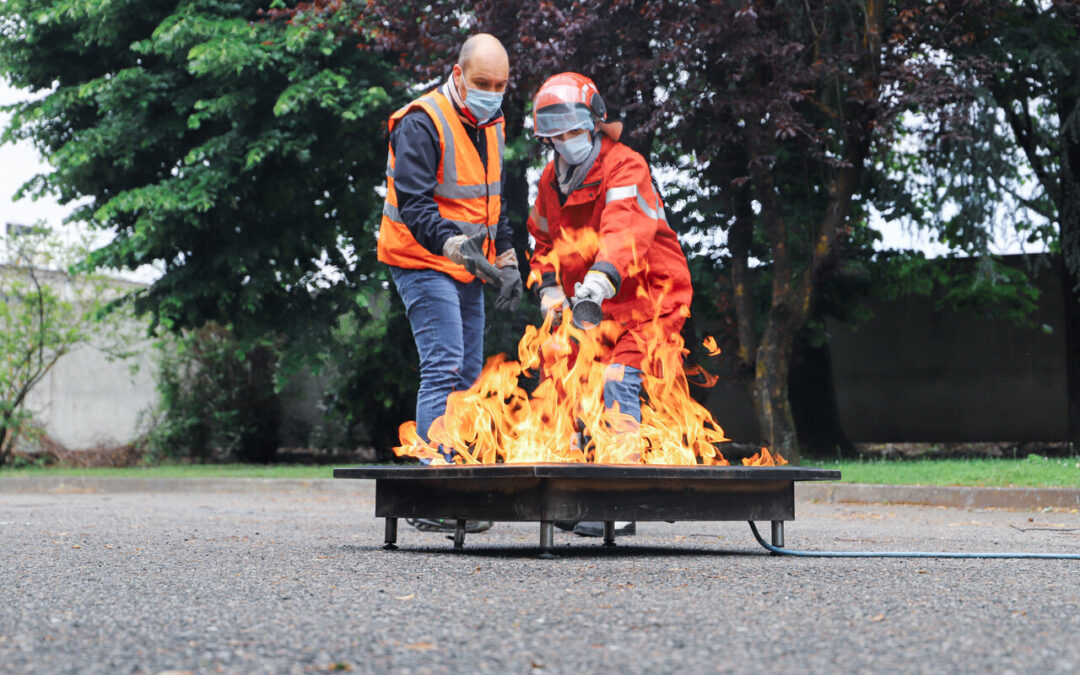The offshore oil and gas industry faces unique challenges in ensuring the safety of workers and assets due to the inherent risks involved in the extraction and production of hydrocarbons. One of the most significant threats in this sector is the potential occurrence of fires, which can have devastating consequences for employees and the environment. To mitigate these risks and maintain a safe working environment, effective fire prevention and response strategies must be implemented and continuously improved.
In this guide, we will dive into the crucial aspects of fire prevention and response in the offshore oil and gas industry. We will discuss the potential risks associated with offshore operations, outline the best practices and specialized equipment required for fire safety, and highlight the importance of training and education in maintaining a strong culture of safety.
Understanding the Risks and Challenges in Offshore Fire Safety
- Identifying Fire Hazards: An essential first step in developing an effective offshore fire prevention strategy is to understand and identify the potential fire hazards. These can include equipment malfunctions, ignition sources, flammable materials, and human error.
- Unique Offshore Challenges: The offshore oil and gas industry presents a unique set of challenges in fire prevention and response. Factors such as remote locations, limited resources, and harsh environmental conditions can complicate fire safety efforts and require specialized equipment and strategies.
Developing Comprehensive Fire Prevention and Response Plans
- Fire Risk Assessment and Management: Conducting thorough fire risk assessments can help offshore operators identify potential hazards and develop management strategies to reduce the likelihood of fire incidents. This process should involve evaluating equipment, processes, personnel training, and emergency response capabilities.
- Designing and Implementing Fire Safety Plans: Developing detailed fire safety plans is crucial for mitigating the risks associated with offshore fires. These plans should include specific procedures for equipment inspection, maintenance, evacuation, and emergency response.
Selection and Deployment of Specialized Firefighting Equipment
- Offshore Firefighting Systems: The unique challenges and risks of offshore operations necessitate specialized firefighting equipment, such as water and foam-based extinguishing systems, fire suppression blankets, and explosion protection systems. These systems must be carefully selected and strategically placed throughout offshore facilities to ensure optimal efficacy in case of a fire.
- Portable Firefighting Equipment: In addition to integral firefighting systems, offshore operations should be equipped with portable fire extinguishers and other handheld devices. These tools should be easily accessible, allowing workers to respond quickly to small fires and prevent their escalation.
Complying with Offshore Fire Safety Regulations and Standards
- Understanding Regulatory Requirements: Offshore oil and gas companies must comply with various fire safety regulations and standards. Understanding and adhering to these requirements helps ensure the proper implementation of fire prevention and response measures, reducing risks to workers and assets.
- Monitoring Regulatory Updates: Staying informed regarding updates to fire safety regulations and industry best practices can help offshore operators refine and enhance their fire prevention and response strategies. Regular reviews and updates of fire safety plans are crucial for maintaining compliance and overall safety.
Prioritizing Employee Training and Education in Fire Safety
- Offshore Firefighting Training: Providing comprehensive firefighting training to all offshore employees, including decision-making, fire prevention practices, and equipment usage, is essential for mitigating fire risks. Workers should understand the full range of fire hazards and know how to respond effectively in case of an emergency.
- Continuous Learning and Retraining: Regular retraining and refreshers courses keep employees up-to-date with the latest fire safety practices and equipment advancements. Incorporating continuous learning into a company’s fire safety program can help maintain a strong safety culture and ensure employees are prepared to respond appropriately to fire incidents.
Incident Reporting and Analysis of Fire Safety Measures
- Encouraging Reporting of Fire Incidents: Creating a culture where employees feel comfortable reporting fire incidents and near misses can provide valuable insights into improving offshore fire safety measures. Encouraging open communication and incident reporting can help identify potential hazards and areas for improvement.
- Periodic Analysis and Improvement: Regularly analyzing fire safety measures and incident data can help offshore operators identify trends, risks, and potential improvements. Incorporating this information into ongoing fire safety efforts is essential for maintaining a strong safety culture and continuous improvement.
Effective Communication and Coordination During Emergency Response
- Clear Communication Channels: Offshore facilities require effective communication channels to ensure timely and coordinated emergency response efforts. These channels may include radio systems, intercoms, or other digital communication methods that facilitate clear and efficient information sharing during fire incidents.
- Coordinated Emergency Response: Effective management and coordination of emergency response teams are essential for successful firefighting efforts in offshore settings. Companies should establish clear roles and responsibilities for employees involved in emergency response, enabling efficient and organized actions during fire incidents.
Integrating Fire Safety with Other Offshore Safety Measures
- Comprehensive Safety Approach: Offshore fire safety efforts should be integrated with other safety measures, such as gas detection, spill prevention, and personal protective equipment. This comprehensive approach ensures a holistic strategy to safeguard workers and maintain a safe working environment.
- Fostering a Safety Culture: Emphasizing the importance of fire safety as part of an organization’s overall safety culture helps ensure employees remain vigilant and proactive in preventing and responding to fire risks. Promoting a safety-first mindset and encouraging employee involvement in fire safety efforts can lead to a more secure offshore work environment.
Promoting Collaboration with External Fire Safety Organizations and Agencies
- Coordinating with Local Firefighting Authorities: Working closely with local fire departments and emergency response organizations can improve offshore fire prevention and response efforts. Developing strong relationships with these agencies can facilitate the sharing of information, resources, and expertise to enhance fire safety measures.
- Participating in Industry Forums and Workshops: Attending industry events and workshops focused on offshore fire safety can provide valuable insights into best practices, emerging trends, and new technology. Networking with other professionals in the field can lead to collaborative efforts that drive innovation and improvement in fire safety standards.
Incorporating Technology and Data in Offshore Fire Prevention and Response
- Fire Detection and Alarm Systems: Installing advanced fire detection and alarm systems, such as heat and smoke detectors, can significantly improve the ability to respond quickly to fire incidents. These systems should be well-maintained and monitored to ensure timely activation and alerts to workers during an emergency.
- Data Analysis and Predictive Modeling: Oil and gas companies can leverage data analytics and predictive modeling techniques to pinpoint potential fire hazards and the effectiveness of prevention measures. This information can be used to create targeted solutions that address identified risks and weaknesses in offshore fire safety programs.
Implementing Safety Management Systems for Offshore Fire Safety
- Establishing a Safety Management System (SMS): An SMS is a structured approach to managing fire safety, incorporating policy, planning, implementation, and continuous review. Implementing an SMS can help offshore operators to better coordinate and monitor fire prevention and response efforts, as well as ensure compliance with relevant regulations.
- Conducting Regular SMS Reviews and Audits: Regularly reviewing and auditing the effectiveness of an SMS can help offshore companies identify areas for improvement and maintain a strong focus on fire safety. These reviews can include internal assessments, external audits, and the involvement of third-party experts to provide unbiased evaluations.
Environmental Impact and Fire Safety Measures in Offshore Operations
- Assessing the Environmental Impact of Fire: Fires in offshore facilities can have significant environmental consequences, including air pollution, water contamination, and damage to marine ecosystems. Companies should carefully assess the potential environmental risks associated with their operations and implement measures to minimize these impacts.
- Incorporating Environmental Considerations into Fire Safety Practices: Offshore operators should consider the potential environmental effects of fire prevention and response measures, such as chemical use in firefighting or waste disposal. By integrating environmental considerations into fire safety practices, companies can contribute to the protection of the environment and sustainable operations.
Lessons from Past Offshore Fire Incidents and Their Application
- Learning from Past Incidents: Analyzing past offshore fire incidents can provide valuable insights into the root causes, contributing factors, and potential preventive measures. By studying these events, companies can inform their fire safety efforts and avoid repeating mistakes that led to previous incidents.
- Implementing Practical Solutions and Improvements: Offshore operators must learn from past incidents by implementing practical solutions and improvements based on the lessons learned. This proactive approach helps to enhance fire safety measures and continuously evolve practices in response to new risks and challenges.
Supporting Workers’ Health and Wellbeing in Relation to Offshore Fire Safety
- Providing Psychological Support: Experiencing fires, emergencies, or drills can be stressful for offshore workers. Companies should have systems in place to support employees’ mental health and wellbeing, offering services such as counseling, stress management, and peer support programs.
- Promoting Physical Fitness: Offshore firefighting efforts can be physically demanding, and maintaining good physical fitness is a vital component of worker safety. Companies should encourage employees to engage in regular exercise and provide resources, such as on-site gyms or sponsored physical activities, to help maintain their physical wellbeing.
Ensuring the Proper Selection of Personal Protective Equipment (PPE) for Fire Safety
- Fire-Resistant PPE: Offshore workers must be equipped with fire-resistant PPE, such as coveralls, helmets, gloves, and boots, to minimize injury in the event of a fire. Companies should invest in high-quality PPE that meets industry standards and provides adequate protection against fire hazards.
- Training and Education on PPE Use: Proper training on the correct use and care of PPE is crucial for maximizing its protective capabilities. Employees should be educated on how to use, maintain, and store their PPE to ensure they are well-protected during offshore fire incidents.
Implementing Fire Drills and Simulated Emergencies
- Regular Fire Drills: Conducting regular fire drills in offshore facilities helps train employees on emergency response procedures and provides an opportunity to evaluate the effectiveness of fire safety measures. Drills should be comprehensive, engaging all personnel on board, and include a thorough review to identify any areas for improvement.
- Simulated Emergencies: Incorporating simulated emergencies into training exercises can help workers practice their response to various fire scenarios in a realistic and controlled environment. These simulations can be tailored to address specific fire risks and challenges in offshore operations, allowing for targeted and practical training experiences.
Offshore Fire Safety in Extreme Environments and Remote Locations
- Adapting Fire Safety Measures for Extreme Environments: Offshore operations in extreme environments, such as Arctic or deep-sea locations, can present unique fire safety challenges. Companies must adapt their fire prevention and response measures to address these specific circumstances, ensuring the safety of workers and assets in these demanding conditions.
- Enhancing Preparedness for Remote Locations: Offshore facilities in remote areas may have limited access to external emergency resources, necessitating self-sufficiency in fire safety efforts. Companies should invest in specialized equipment, in-depth training, and on-site support personnel to ensure they are adequately prepared to handle fire emergencies without external intervention.
Final Thoughts
The dynamic and demanding nature of offshore oil and gas operations necessitates the implementation of robust fire prevention and response measures to ensure worker safety and asset protection. By understanding the unique challenges of offshore environments, investing in specialized equipment and training, and fostering a proactive safety culture, companies can maintain a safe and secure working environment.
At Tiger Safety Rentals, our team of experts is committed to supporting your organization with specialized safety services and equipment specifically designed for the oil and gas industry, including offshore fire safety solutions. Partner with us to advance your offshore fire prevention and response efforts, guaranteeing optimal protection for your workforce. Contact us today to discover how our expertise and resources can contribute to the ongoing success and safety of your company.

